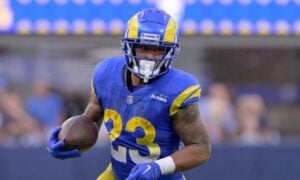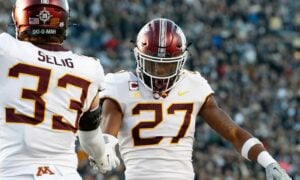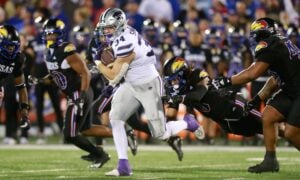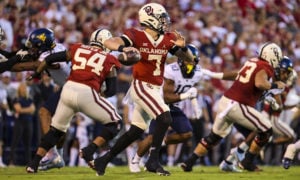Dynasty Fantasy Football Mailbag: Trading Picks for Established Players

Welcome back to the DLF Mailbag, the preeminent mailbag in all the dynasty fantasy football land. As a reminder, there are multiple ways to pose your burning questions! I’ll be soliciting weekly feedback via X/Twitter (look for a new pinned tweet each Monday), and you can also reach out using our Discord channel, or the old-fashioned way (via our online webform).
The score was tied 10-10, just as Jimmy Eat World took the stage at halftime in the Divisional Round clash between the Texans and Ravens, delighting the many older Millennials in attendance. From that point onward, quarterback Lamar Jackson took the game over in helping rip off 24 unanswered points, leading to a final score of Baltimore 34, Houston 10.
Causation, correlation, etc., but I prefer to give credit where it’s due, especially when it’s this obvious. The band entered the fray in The Middle of the game, and the Ravens subsequently experienced a proper amount of Sweetness. Don’t believe the resultant effect? Just ask them!
The lesson, as always, is there are factors we simply cannot predict or control. But hopefully we’re staying diligent in this, the off-season, best positioning ourselves to avoid Pain in our Futures!
Let’s get to it!
Superflex-ing Your Wide Receiver Muscles
Is it ever a good idea to trade up for a WR in a Dynasty Superflex rookie draft? (Or: Who would you trade up for in this year’s class?)
— joseph rossi (@ABQjoe_r) January 15, 2024
As we know, certain league formats may emphasize and deemphasize variable positions. The superflex format, where managers can start up to two quarterbacks each week, is probably the quintessential example. To that point, while it would be somewhat rare to see a signal caller selected in the first round in a 1QB format, it may be even rarer to not have most or all the day one (NFL Draft) quarterbacks off the board in the first round of a superflex rookie draft.
While this is obviously an important foundational paradigm affecting quarterbacks, what it doesn’t inherently do is negatively impact the value of other positions. To the contrary, with signal callers flying off the board earlier than they would otherwise, a sound argument could be made that running backs, receivers and possibly even tight ends become relatively more valuable. It’s not as if these players have all of a sudden become less talented, it’s just that in a supply-and-demand fantasy world they will be easier to come by.
With this preamble in hand, it’s probably fair to note I haven’t actually answered your question yet! Though given the preceding text, you may have already gleaned my overarching philosophy – if there’s a player you want, regardless of the format, you should do what you feel you need to do to maximize your chances of acquiring him. When it comes to this year’s crop of pass catchers, I’d absolutely be interested in attempting to nab either Marvin Harrison Jr or Malik Nabers. In order to do so, my suspicion is you’ll need pick 1.02 for the former, and pick 1.04-1.05 for the latter. Even with USC quarterback Caleb Williams likely to be selected first overall, I wouldn’t actually fault anyone for still going with Harrison at 1.01 in a rookie draft, similar to with Bijan Robinson last year. He seems likely to be that good.
But here’s where it gets interesting, as shown in our DLF superflex rookie rankings:
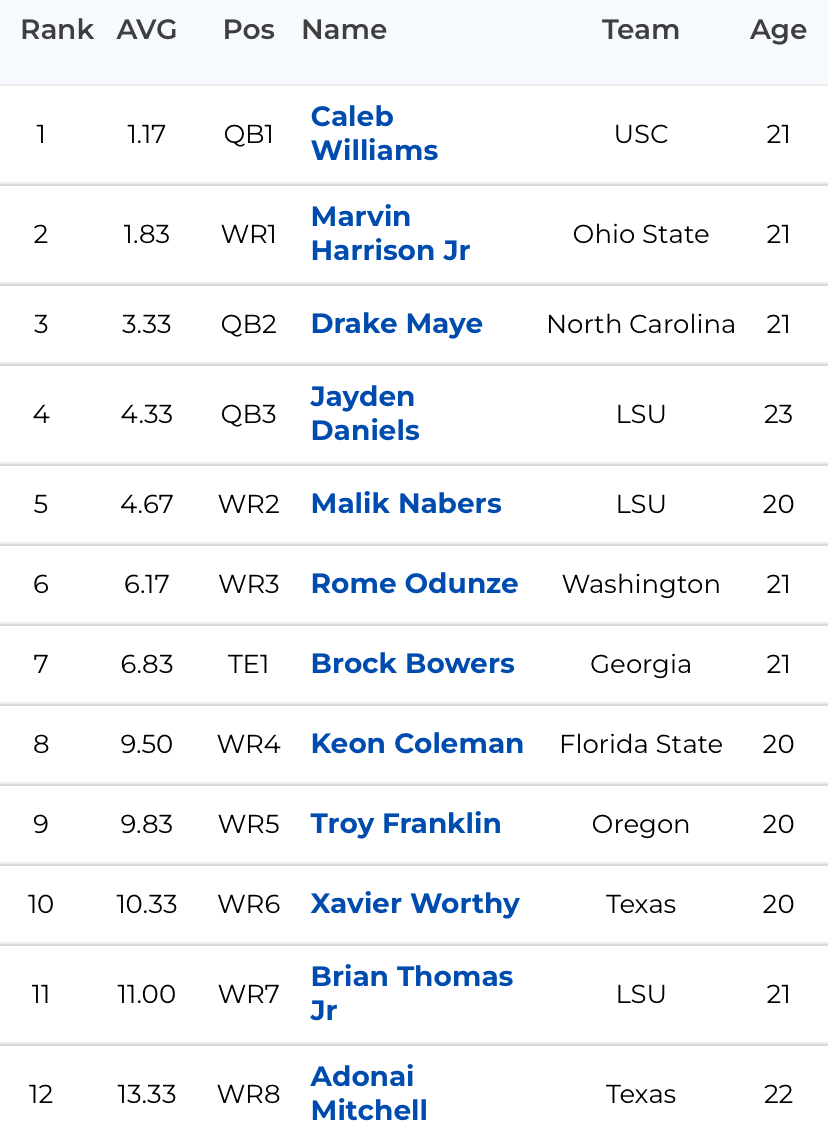
After Nabers, six of the remaining seven players are receivers, which means eight of 12 (67%) first-round players all reside at the position. And following Washington’s Rome Odunze (average ranking of 6.17), the next four wideouts are clustered between rankings averages of 9.50 and 11.00, with Texas’ Adonai Mitchell then closing out the round. While noting the typical caveat that the NFL Combine and NFL Draft may lead to changes in this hierarchy, much like with this past year 2024 appears to feature a glut of talent at the position.
To be clear, this isn’t to assert these players are interchangeable. But rather, it’s to say that if you don’t have a clear preference amongst them, odds are you’ll be able to come away “INSERT WR NAME HERE” in the back half of the first round.
With that said, if you lack a first-round pick or early second-round pick, this is where you may want to think about trading up. As shown by the next 12 players in DLF’s superflex rookie rankings, there’s a clear tier break following Mitchell. This is where you’d likely run the risk of not being able to select a top-level asset at the position.
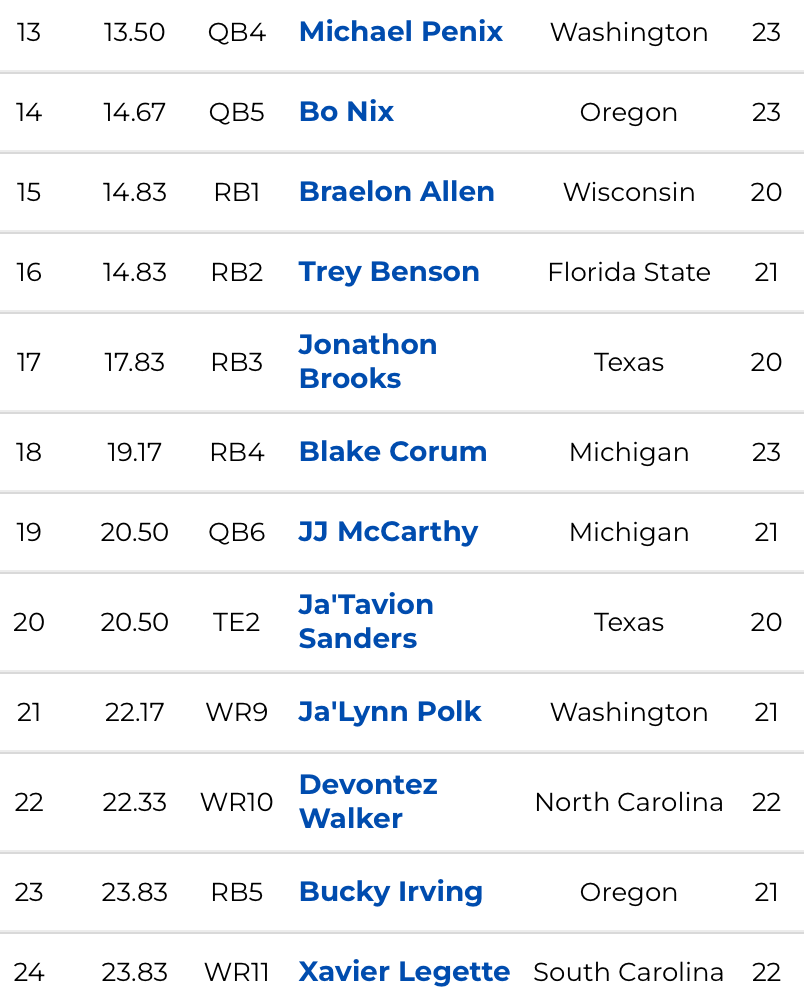
Shiny New Toys, or Rusted Old Favorites?
Rebuilding dynasty team- do I Trade 1.02 and/or 2.02 picks for established players? I feel close!
— ChicagoBrian (@chicagobrian) January 16, 2024
As I noted in the Mailbag edition a couple of weeks back, one of the first things teams need to do in the off-season is make an honest assessment of where they stand as compared to their league-mates. While acknowledging this is subject to change over the coming months with free agency and the NFL Draft, it serves as an important early barometer when assessing competitiveness in the coming year. Based on your tweet (or whatever it’s called these days), you’ve already begun to do this, and believe you may just be a couple of pieces away from the promised land!
Obviously I’ve not seen your team, nor those of your league-mates. And in my many years playing dynasty football, I’ve seen league champions miss the playoffs the following year, and also-rans make a few savvy moves enabling them to rise from obscurity to reach the mountaintop. I only note this because you appear to have earned the upcoming pick 1.02 – this could have involved injuries, bad luck and other mitigating factors, but it’s notable nonetheless.
So the question becomes what do you feel you’re “close” to? Is it legit championship contention, or a lower-tier playoff team? Answering this type of question could inform your move, as it’s prudent to remember that upside is not a single-variable likelihood. Much as with individual players, upside is not only the ceiling they theoretically possess, but also their likelihood of reaching it.
Why am I mentioning this?
Let’s consider a hypothetical equivalency I noted last week, of DeVonta Smith and pick 1.02. Smith just concluded a solid if perhaps unspectacular campaign that resulted in a fine 81-1,066-7 line, despite a less efficient Philadelphia offense than in 2022. His ADP rose slightly from 23.0 in September to 16.2 in January, but also dropped from a peak of 11.8 in October.

Let’s compare this to a trio of high-performing rookie pass catchers in Zay Flowers, Jordan Addison and Sam LaPorta.
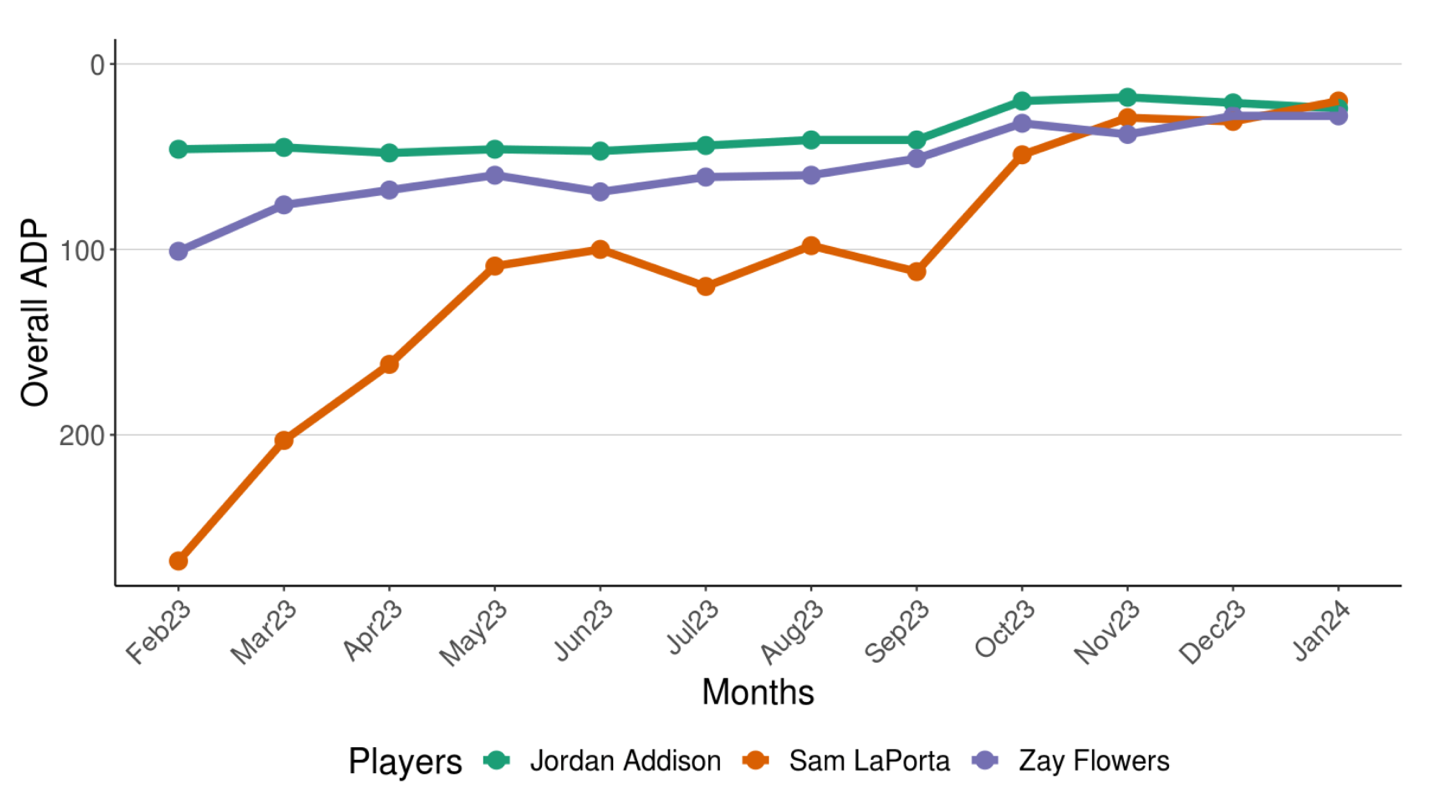
Flowers finished the year with a 77-858-5 line, Addison concluded with a 70-911-10 campaign, and LaPorta complied a fine 86-889-10. LaPorta’s rise is the most understandable, as he incredibly finished as the overall PPR TE1. Addison was a backend PPR WR2 and Flowers a midrange PPR WR3, but all three players now reside within the top 30 picks in startup drafts.
I note this because a similar or better year from Nabers, which wouldn’t be unexpected, will result in a relatively larger gain in value than we’d likely see from a veteran like Smith, despite the fact he’s only just concluded his third season. Players with strong collegiate profiles and draft pedigrees who put forward reasonable numbers as rookies possess a ceiling that non-elite veterans will simply struggle to match. So if you aren’t as close to the top of the league, I would much rather have the rookies, given the fact they’re more likely to appreciate in value.
With that said, I have no issue looking to swing a deal for a more established player. While veterans are perhaps a bit more “boring” than their freshman counterparts, boring can still help you win. If I was selling off pick 1.02, I would want a younger veteran like Smith, Jaylen Waddle, Tee Higgins or DK Metcalf. However, per DLF’s Trade Analyzer, you may need to add pick 2.02 to the equation in certain of these scenarios.
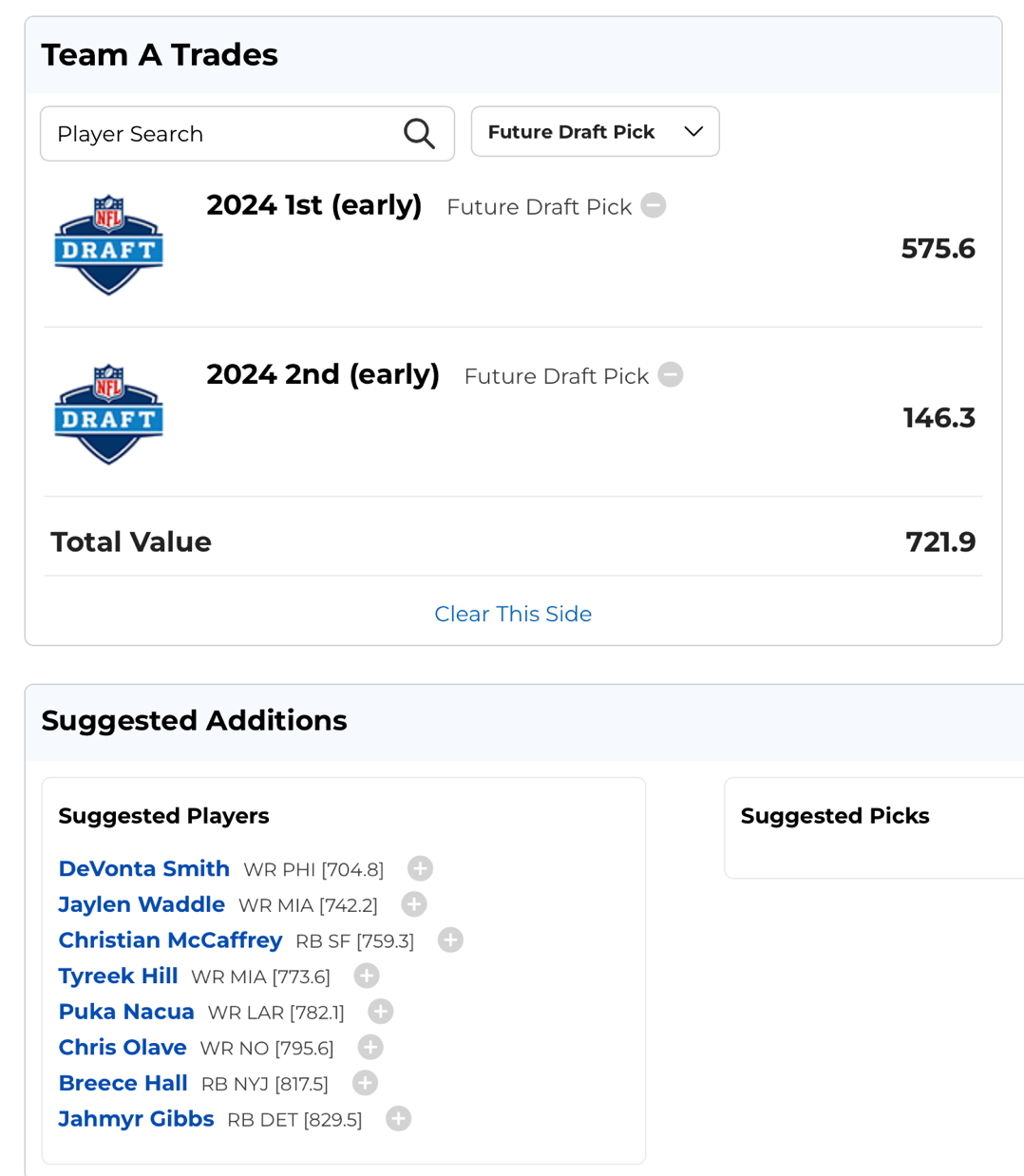
- Dynasty Fantasy Football Mailbag: Justin Jefferson Or A Bundle Of Draft Picks? - April 23, 2024
- Dynasty Fantasy Football Mailbag: Is Kendre Miller Valued Unfairly? - April 17, 2024
- Forgotten Dynasty Veterans: Bottom Tier - April 9, 2024






